In early 2020, the start of the pandemic sparked many unique market trends as consumers rushed to prepare for virtual school, remote work, and a lot more time spent cooking, cleaning, and finding entertainment at home. Two years later, people are planning for travel, get-togethers, and other returns to social normalcy. But one pandemic trend continues to hold: bulk buying. In 2021, sales at bulk retailers like Sam’s Club and Costco increased 26.6% compared to the previous year. With time spent at home dwindling, why are shoppers still drawn to buying in bulk?
Why are consumers buying in bulk?
Bulk buying began largely as panic buying in response to the pandemic. As social distancing guidelines, work-from-home orders, travel restrictions, virtual school arrangements, mask mandates, and other safety measures took hold, consumers’ buying habits evolved out of both necessity and concern over newfound uncertainty about the future.
Demand for specific products — like coffee beans and nail polish — shifted dramatically as the daily routines and future plans of consumers around the globe changed overnight. The more it became clear that these changes were sticking around for the foreseeable future, the more consumers settled into new buying habits.
When it comes to stocking up on shelf-stable and bulk-quantity products, those habits are holding on — and even increasing. In 2020, unit sales and revenue for bulk pantry goods on Amazon peaked in June before tapering towards the end of the year; at the start of 2022, unit sales in the category were up 13% from those numbers and revenue was up nearly 10%. So why is this habit still trending?
Preparation
Even as the initial peak of the pandemic faded, consumers held tight to the reminder it brought about preparedness in general. Emergency food supply products and brands, like Augason Farms and ReadyWise, are still seeing the impact of consumers’ increased attention on emergency preparedness. Both brands have seen revenue for some products increase by or near four figures on Amazon in the last 6 months.
This Augason Farms Breakfast Emergency Food Supply 4 Gallon Pail saw a nearly 1000% revenue increase over the last 6 months.
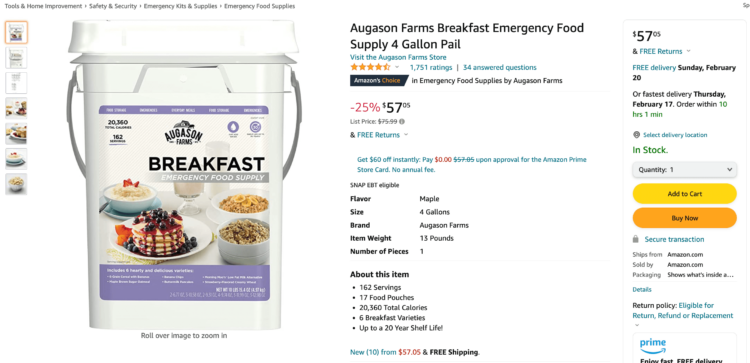
Revenue for ReadyWise’s Emergency Food Supply Kit has increased over 5000% on Amazon since August 2021.
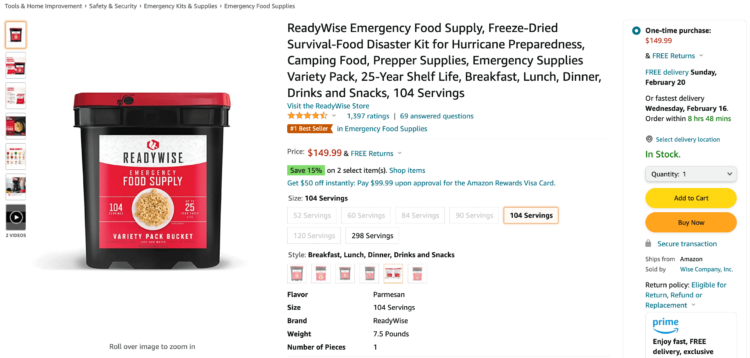
New living spaces
Without the geographical limitations of an office, consumers now have more freedom in choosing where they live. This has fueled a steady trend of moving from cities to suburbs that predates the pandemic, and fewer Americans would now prefer to live in cities than before COVID. All of this means that more consumers are still trading in storage-short apartments for larger homes with plenty of room (including full pantries) to store bulk items.
Office spending moved home
Like bulk buying, the work from home trend is holding on. Although some companies are discussing bringing workers back to the office, nearly half of full-time employees in the U.S. telecommuted all or part of the time in 2021, and 9 in 10 want to continue doing so this year. Working from home means that people are now consuming more at home, too: lunches out are now lunches in, morning trips to the cafe are trips to the coffee maker, and the influx of free time without a commute has people doing more at home.
A performance snapshot of Amazon’s coffee category over the past two years reveals how working from home continues to impact both consumer spending and competition: brands, ASINs, unit sales, and revenue in the category have all risen since March 2020.
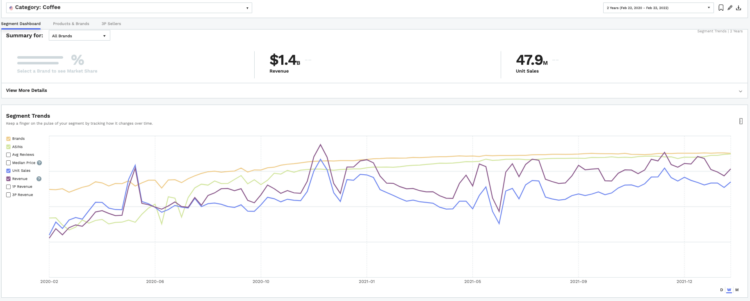
Pricing and availability concerns
Disruptions due to supply chain shortages ballooned in 2021, leading to empty shelves (physical and digital) and a surge in consumer prices. These shortages impacted three-quarters of Amazon sellers, with nearly 40% experiencing inventory delays longer than three months and 30% losing over $10,000 in sales. As shoppers continue to worry about supply chain disruptions and rising costs, they are buying in bulk for discounts and availability as well.
What are consumers buying in bulk?
While consumers are buying in bulk far more than they were pre-pandemic, they certainly aren’t buying everything in bulk. As demand for bulk quantities of some products has boomed, the urgency to stock up on others has dramatically declined since the early days of the pandemic.
Grocery items
The category that has seen the biggest boost from the bulk buying trend on Amazon is grocery. In 2021, the volume of sales in food and beverages in the United States grew, as did the average volume per package size that consumers purchased. For some brands like Dole, this led to a nearly 50% YOY increase in revenue on Amazon for bulk products like canned fruits and vegetables. It’s also clear that shelf stability is a top concern for consumers purchasing in bulk: revenue for bulk dehydrated and freeze-dried foods exceeded its early-pandemic peak in October of 2021 and has been steadily rising since the start of 2022.
This 6-pound bag of powdered milk has had a revenue increase of over 3000% on Amazon in the last 6 months.
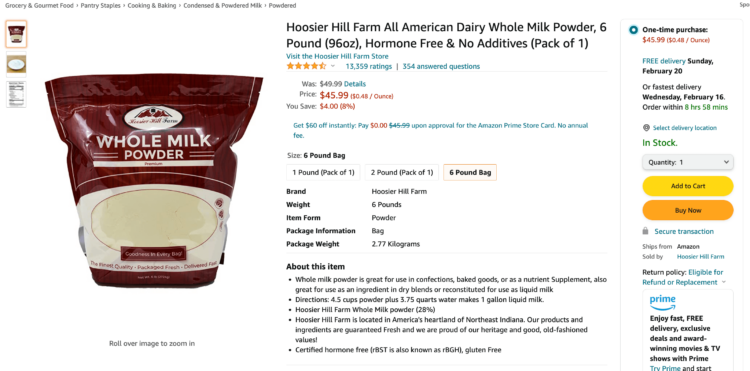
Trends in Amazon purchases of dry pasta, rice, and beans also reflect consumers’ move toward bulk buying and reveal a bit about the way sellers have responded. Revenue for these dry goods remains over 70% higher on Amazon than it was in March 2020, and there are nearly 30% more ASINs and 40% more brands across the three categories.

Food storage and preservation supplies
With bulk grocery buying still on the rise, it’s not surprising that consumers seem to be keeping up with DIY food preservation habits they began during the first wave of the pandemic. In 2021, sales of chest freezers on Amazon more than doubled overall, while some canning and food storage products have seen unit sales jump between 250-450% since August 2021.
Amazon revenue for this 7.1 Cu. Ft. SMETA Freezer has increased nearly 600% in the last 6 months.
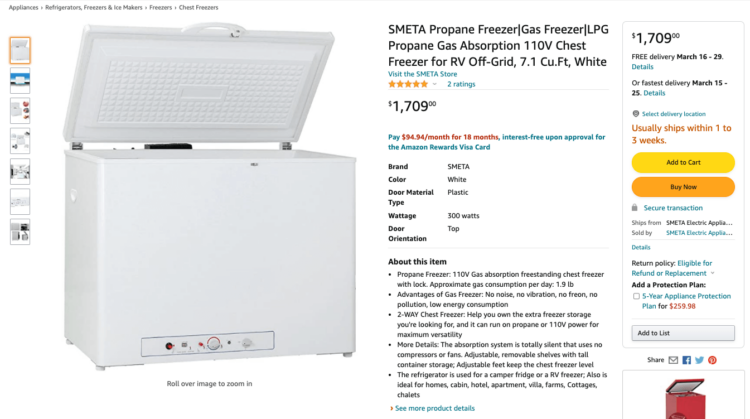
Unit sales of this Canning Essentials Kit have increased 432% on Amazon in the last 6 months.
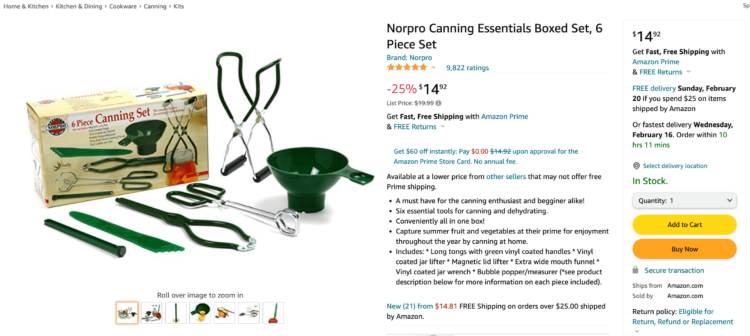
Unit sales of these Airtight Food Storage Jars have increased 285% on Amazon in the last 6 months.
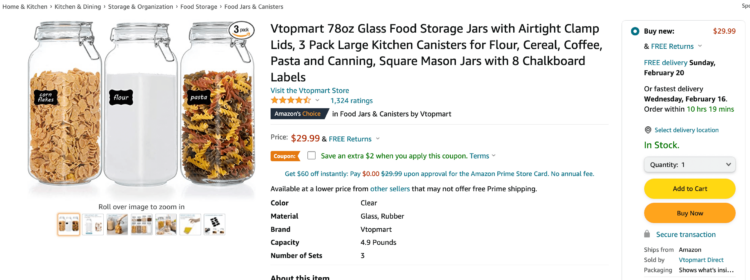
Private label items
As consumers have set their sights on stocking their pantries and freezers, brand loyalty may be building for those retailers offering products in bulk quantities. In addition to increased membership rates (at record levels in some cases), wholesale clubs like Sam’s Club and Costco have enjoyed a rise in sales of their private label products. The growing interest in these private labels is reflected in the Amazon sales of each brand: Kirkland Signature (Costco) has seen a 21% increase in unit sales over the last year and Member’s Mark (Sam’s Club) has seen a 54% increase.
Paper goods + cleaning supplies
Not all bulk buying trends are sticking around. Some market segments that were flooded with new competitors as demand rose in tandem with the pandemic are now seeing a steady decline in sales. While the number of brands in the paper goods segment on Amazon — which encompasses products like toilet paper, paper towels, and napkins — has increased by nearly 70% since its two-year peak in November 2020, unit sales have decreased by 45%.
For this 20-roll pack of Cottonelle toilet paper, unit sales have dropped over 90% between December 2020 and December 2021.
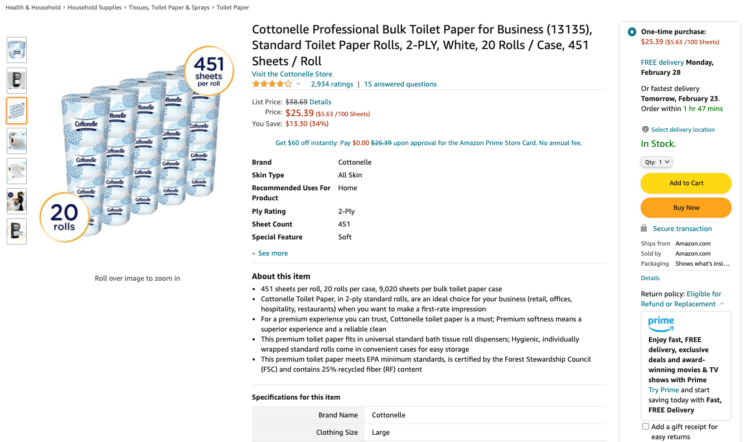
A similar slowdown is true for bulk quantities of cleaning supplies, the Amazon revenue for which hit a two-year peak in September 2021 but has been steadily declining ever since.
Revenue for this 10-pack of Mr. Clean Magic Erasers has fallen 71% on Amazon in the past 6 months.
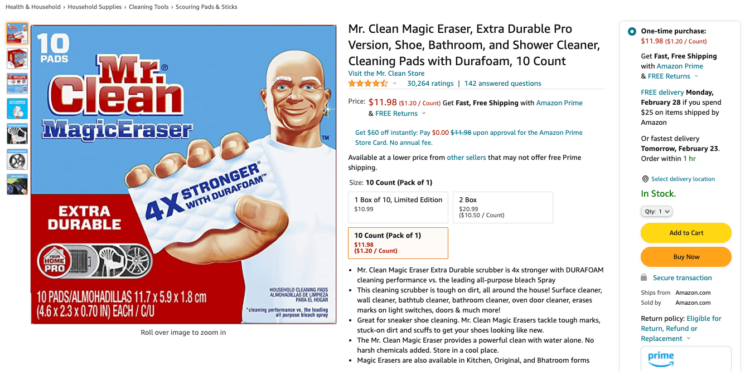
How can brands and sellers leverage the bulk buying trend on Amazon?
Although consumers are eagerly preparing for post-pandemic life, the bulk buying trend’s hold on certain product categories clearly isn’t letting up yet. With most of the inciting factors likely to stick around as well, there’s time and opportunity for brands to leverage this trend on Amazon in a number of ways.
Increase product offerings
Nearly half of Amazon brands are looking to launch new products or expand existing lines in 2022. If your brand is one of these, the bulk buying trend could help you get there by making room to offer new quantities of items without launching an entirely new line of products. It can also bolster new product research by revealing opportunities to jump on market segments where competition is not keeping up with demand. In the vacuum sealing supplies segment, for example, the number of brands has decreased nearly 25% in the last quarter while unit sales have increased almost 35%.
Opportunities could be ripe in vacuum sealing supplies: revenue for this Foodsaver Vacuum Sealing System has exploded, with an over 5000% increase during the last quarter.
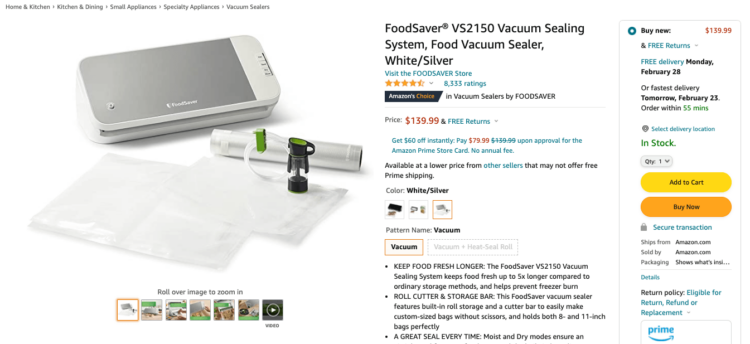
Build brand loyalty
59% of Amazon sellers sell private label, giving them complete control of the marketing, packaging, and promotion of their products. Just as brick-and-mortar wholesale clubs have seen increased sales of their private label products, your brand can potentially boost awareness with bulk-quantity products that create a direct association between your brand and this buying trend for consumers.
Make your products stand out
Competitor research may uncover opportunities to help your products stand out by offering them in bulk quantities. If another brand has a higher share of the market for a certain product on Amazon, offering yours in bulk quantities could help you stay competitive by serving customers that are being missed by other available options.
Reduce overhead + increase revenue
Profit margins are already high selling on Amazon: 57% of brands have profit margins over 10%. Since many suppliers and manufacturers offer quantity discounts, you could potentially reduce overhead and increase revenue per unit by taking advantage of these discounts while offering bulk quantities to your own customers.
Inform advertising spend + strategy
Like all trends, bulk buying can be invaluable when it comes to planning your Amazon advertising spend and strategy. Whether you are introducing new products entirely or just introducing existing products in bulk quantities, appealing to the trend in your ad messaging can help drive people to your brand. Researching keywords related to shelf-stable products and bulk quantities can also reveal new potential tactics for targeting and bidding.
Spark ideas for other platforms
Understanding how the bulk buying trend is influencing your customers on Amazon can lead to strategic ideas about paid and organic content on other platforms, like social media. Knowing the bulk products consumers are interested in on Amazon can help you build messaging that leads them to your brand on other platforms as well.
What does the bulk buying trend mean for the Amazon market?
Regardless of pandemic sentiment, bulk buying is sticking around — at least for now. For Amazon sellers, it affords the potential to expand product offerings without having to build and launch new lines. For large brands who have the advantage of precise product control, leveraging the ongoing trend with private label bulk products can help to push brand recognition and sales at the same time. For both, it’s an opportunity to uncover new ways to grow their presence and potential on a marketplace that boasts over 300 million customers around the globe.
Methodology
The product data in this report is representative of the U.S. Amazon market. Market insights on Amazon products were sourced from Jungle Scout Cobalt, an industry-leading market intelligence and product insights platform powered by more than 1.8 billion Amazon data points that are monitored every day. Two-year data encompasses the period of February 21, 2020 – February 21, 2022. Year-over-year revenue and sales increases/decreases are comparisons of the period February 21, 2021 – February 21, 2022. Revenue and unit sales changes over the last 6 months are based on data from the period of August 1, 2021 – February 21, 2022.
Contact [email protected] today to see how Jungle Scout Cobalt can help you explore sales data and provide strategic insights into consumer behavior on Amazon.
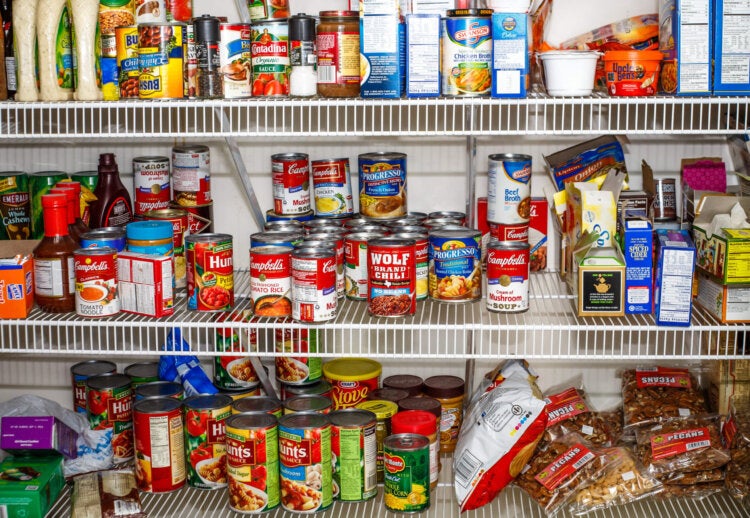

 1 Comment
1 Comment
One comment on “Bulk Buying is Still In: How to Leverage the Trend on Amazon”
Superb blog and very informative